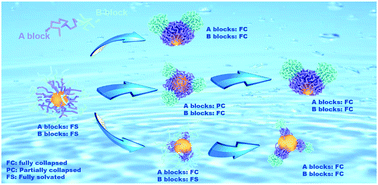Versatile fabrication of patchy nanoparticles via patterning of grafted diblock copolymers on NP surface
Abstract
Patchy nanoparticles (PNPs) have received increased attention since they serve as a new type of self-assembly unit. However, the precise synthesis of PNPs with target patch numbers and their spatial distribution on a nanoparticle (NP) surface are still a formidable challenge. A recent experimental study [R. M. Choueiri et al., Nature, 2016, 538, 79] has demonstrated that following a change in the solvent quality, the collapse and thermodynamically driven segregation of the grafted homopolymer (HP) chains on the NP surface can lead to the formation of surface-pinned micelles, and therefore, PNPs. In this study, by using coarse-grained molecular dynamics simulations, we demonstrate that the collapse of the grafted diblock copolymer (DBC) chains on the NP surface can also lead to the formation of PNPs, but in a more controllable manner with target patch numbers and symmetric surface distribution. In addition, our studies have shown that PNPs formed from the collapse of surface-grafted DBC chains are superior to those formed from the collapse of HP chains. We have shown that the use of DBC can generate more spherical patches than that using HP. More importantly, grafting DBC chains on the NP surface offers a larger adjustable parameter space due to their distinct properties, tunable volume fractions of the two blocks, and the different interaction types with the NP surface. In addition, solvent-phobicity and the sequence of collapsing of each block can also be utilized to control the formation pathway of the PNP structures.



 Please wait while we load your content...
Please wait while we load your content...